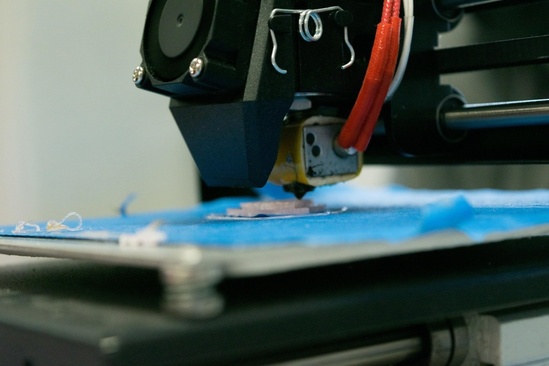In mid-April, the Hatfield Marine Science Center put on another successful Marine Science Day--an event dedicated to involving and educating the community about current marine research being conducted at this facility. Amongst the wide variety of projects and exhibits being displayed, we were able to dedicate a table to the Pyrosoma atlanticum (pyrosome) research being done here in Newport. The theme of this years Marine Science Day was 'Technology and Science', spurring exhibitors to think about how technology is incorporated in their methodology or how it could be in the future. For the pyrosome exhibit, a 3D printer was used to not only print the pyrosome models that were displayed on the table, but also to do real-time printing for visitors to watch.

Pyrosoma atlanticum display at Marine Science Day 2019. Photo: NOAA Fisheries

3D printer building a pyrosome model. Photo: NOAA Fisheries
3D printers are already being used for medical research, and have even been utilized to build prosthetics and skull segments for medical patients. Expanding upon this application, we believe 3D printing technology has incredible potential for scientific modeling, experimentation, and engineering. Our display had pyrosome models in a variety of sizes that visitors could pick up and touch as well as small pyrosomes built with a glow-in-the-dark filament. Visitors were able to charge these glow-in-the-dark models with flashlights and then view them in a Dark Ocean box to see them bioluminesce just like a real pyrosome would.

3D printed pyrosome models that have been completed and one cross-sectioned model showing the internal structure. Photo: NOAA Fisheries
In addition to the 3D printed models, we had preserved specimens that could be viewed as well as a slideshow of field collections and lab experimentation, and a poster we used to educate the community about this peculiar species. Since pyrosomes appeared in mass abundances from 2014-2018 off the coast of Oregon, there has been a coordinated effort to discover why they're here and what impact their presence has on the pelagic ecosystem. The research being conducted on pyrosomes in Newport is some of the first of its kind, as very few studies have focused on these creatures. Educating the public on the importance of expanding our knowledge of pyrosome's contribution to the ecosystem is vital for inciting interest in this species, the environment, and science itself.

Elizabeth Daly, a member of the pyrosome project, helping children view the glow-in-the-dark pyrosome models in the Dark Ocean box. Photo: NOAA Fisheries
We've included the file used to print the pyrosome models. The 3D file was produced by Elizabeth Daly, elizabeth.daly@oregonstate.edu, and distributed by Dr.Kim Bernard of Oregon State University.
If you have access to a 3D printer and want one of your own feel free to download it! Feel free to share and adapt the design file. Click here to upload the file. Please refer to the disclaimer on the bottom, left navigation panel.


